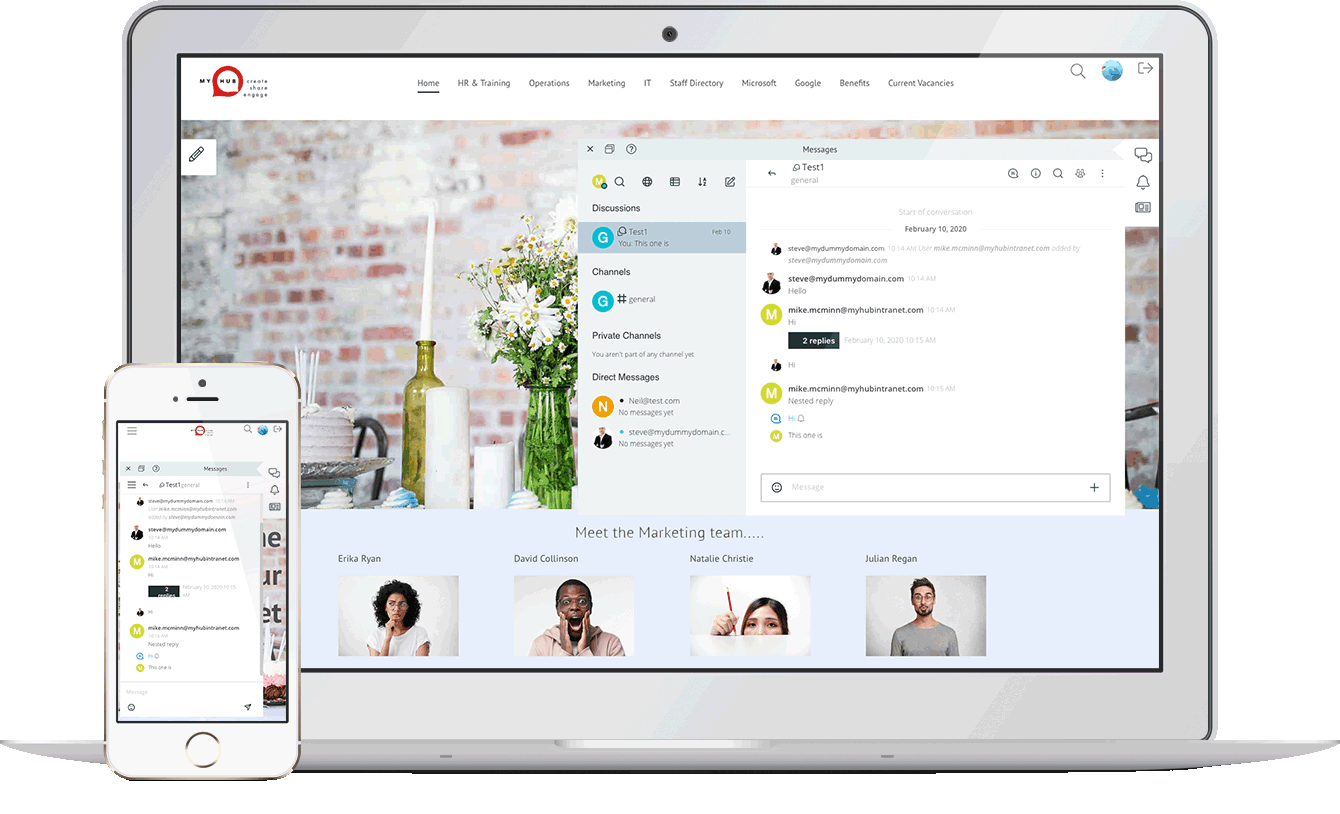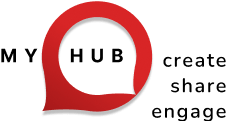Team Collaboration
How To Help Staff Connect, Encourage Ideas, And Move Work Forward
Share. Communicate. Innovate

Team collaboration is a prominent trait among today’s winning organizations. Done right, collaboration aids better decision-making, innovative thinking and improved productivity. Staff are happier, performance is boosted, and there’s less risk of error.
But many organizations have yet to figure out how to help colleagues work better together to achieve a common goal.
The good news is that there are tools and techniques that have proven to nurture a strong collaborative culture within the workplace.
Here, we shed light on the causes of poor collaboration, tips for improvement, and collaboration software that enables co-workers to share ideas and improve internal communications.
What Is Team Collaboration?

The definition of team collaboration is when two or more people work together to achieve a common goal. This is done through idea sharing, planning and executing in unison. In contrast to working on one’s own, team collaboration is regarded as a more productive way to get work done, and carries less risk.
Tackling a major project – such as a new product launch or the introduction of a new internal process – usually requires a teamwork approach. This entails bringing together a group of employees to allocate and complete tasks, within a set timeframe.
These days, with technology overcoming geographical barriers, virtual teams are popular. Companies are now appointing the best people for a project – regardless of their work location – to form part of a team and collaborate. This development has created new opportunities for businesses to innovate – but is not without its challenges.
Why Is Team Collaboration Critical In The 21st Century?

Never before has the workplace been so diverse. For the first time in history, five generations are working side-by-side. Each employee has a unique perspective. Their opinions are formed by their own personal experiences. And they have different communication styles – some prefer face-to-face, others the written word.
Such differences are a lot to manage, particularly when complex, project-based decisions must be made.
How a team interacts with each other will influence the final outcome. Communication, knowledge transfer and equal respect for each team member are essential for a high-performing team.
Younger generations joining the workforce are eager to further develop the collaborative skills they’ve learnt during education. They place place greater support on social tools for collaboration than their older colleagues (49 per cent millennials vs 31 per cent baby boomers). And considering that 46 per cent of 2020’s workforce are millennials (compared with 36 per cent six years ago), employers must act upon this growing generation’s preference for building team dynamics.
Furthermore, around 75% of employees now rate teamwork and collaboration as crucial to their performance.
Reasons For Poor Team Collaboration
It’s a common scenario when a collection of people come together to solve a problem, cross-functionally. There may be representatives in the room from IT, Sales, Product and Finance.
When collaboration fails, it’s often because these individuals partially listen to others points-of-view, but do not fully seek to understand what they were actually saying.
Each representative remains in their own paradigm rather than genuinely taking on board and seeking a solution based on other perspectives.
To counter this, effective collaboration requires recognition of diversity; that each individual has their own thought process and purpose. This requires greater understanding of the team individuals, and the concerns they may be feeling.
These could include the following:
- Skepticism about the success of the project i.e.‘doomed to fail’
- Uncertainty around who does what in the team, and where tasks and responsibilities sit
- Misinterpretation or miscommunication: wrongly assuming all staff have the same understanding
- Lack of direction, KPIs and milestones set out from the start
- Conflicting priorities: failing to appreciate an employee’s current workload before adding more
- Forcing staff to communicate in ways that may be uncomfortable for them i.e. introverted employees making team presentations
How To Improve Team Collaboration
Successful team collaboration is hard work. With so much to consider – silos, company culture, staff at different locations, leadership styles – good team collaboration doesn’t happen by accident.
Furthermore, Harvard Business Review has exposed an interesting paradox at play, based on its research into team behavior:
“Although teams that are large, virtual, diverse, and composed of highly educated specialists are increasingly crucial with challenging projects, those same four characteristics make it hard for teams to get anything done.
“To put it another way, the qualities required for success are the same qualities that undermine success. Members of complex teams are less likely to share knowledge freely, to learn from one another, to shift workloads flexibly to break up unexpected bottlenecks, to help one another complete jobs and meet deadlines, and to share resources.”
It also found that the higher the educational level of the team member, the more challenging collaboration appears for them.
But there are some best practices for building effective collaboration strategies, as follows:
Define And Repeatedly Communicate The Team’s Goals
This is the first step to bringing together a group of people. Goals should be reiterated at the start of daily huddles, referred to when key decisions are underway, and repeated across all communication channels (your intranet, for example).
Promote Open Communication Particularly When Faced With A Roadblock
This is where technology has become a game-changer. Instead of waiting for the next round-table meeting to overcome a roadblock, intranet tools such as forums, instant messaging, and shared files allow members of the same team to work through a problem collaboratively at pace.
Create Structure Within Meetings And Give Staff Time To Prepare
WIP (work-in-progress) meetings are an important part of effective project management. Ahead of each meeting, share agenda items, action lists and related reading material with all members of the team so there are no frustrating delays when teams meet.
Encourage Creativity And Free-thinking: All Ideas To Be Respected
Brainstorming sessions can be fun and fruitful. Team leaders must give advance warning though so staff can do their own research. And if you’re the manager, resist the urge to direct and jump in immediately with your ideas, as staff may feel obliged to follow.
Log Important Decisions And Their Backstory
Avoid the “he said/she said” nature of spontaneous conversations; make sure ideas are contextually documented in a central space, accessible for all, and not lost in the moment.
Invest in Collaboration Tools
Team collaboration tools have shown the way here. Employees can set up team channels where decisions can be made in real-time. Slack, the popular chat tool, has been joined by a host of other instant messaging tools, virtually eliminating the need for traditional email. Video conferencing, in the wake of Covid-19, has become the default meeting format. And forums are another effective channel for effective team collaboration.
Check For Understanding
Nodding heads does not necessarily mean agreement and understanding. Many co-workers won’t like to admit they don’t understand something. Reiterate major decisions – during and after meetings – providing clarity and an opportunity for others to ask further questions. Engage in two-way communication with all members when possible.
Create Ways For Less Outspoken Team Members To Contribute Ideas
Not everyone has public speaking skills. Shy people will not feel comfortable sharing their idea in a room full of colleagues, but may happily submit an idea via a forum or chat channel. Make it known that individual thinking is unique and valued, and that every team member should be able to communicate with equality and authority.
Share Experience, Knowledge And Resources
Use an intranet to capture treasured insights – physically and virtually with file-sharing software. This will save mistakes being repeated, and knowledge walking out the door when someone leaves. Don’t leave this to chance: embed a process for eliciting and storing this valuable intelligence as part of your regular WIP meetings. Add tags to meeting notes that can be searched for later on.
Acknowledge And Celebrate Individual And Team Success
Highlight individual qualities and the special skills that each team member brings to the table. Go big when a milestone or key task has been ticked off with a team building celebration event. This boosts morale and makes people feel valued.
Appoint Task And Relationship-Oriented Leaders
HBR research found that the most productive and innovative teams had leaders who could outline clear goals and responsibilities and easily switch to relationship-building mode i.e. smoothing out internal tensions.
Limit Group Sizes
Not always possible – particularly if you’re about to organize the next Olympics – but aim to keep teams small enough so that staff get to know (and respect) each other, and ideas exchange freely. Big teams tend to be more vulnerable to tunnel vision, or the ‘squeakiest wheel wins’.
❝
Collaborative teams are 5 x higher performing as they feel motivated towards a common goal
Source: i4cp
Team Collaboration Trends
Team Collaboration tools are evolving to suit the changing needs of businesses today.
Flexibility, scalability, and compatibility with existing systems increasingly matter. Because of this, enterprise players such as Cisco, Slack and Microsoft have no choice but to integrate with each other.
Some other noticeable trends in team collaboration include:
Artificial Intelligence
Machine learning tools and bots can help an entire team improve the way they collaborate by making it easier to find information instantly. They can also offer things like real-time translation and transcribing during video conferencing meetings.
Unique Experiences
As more technology vendors come to the integration and interoperability party, open-source platforms with the help of APIs are enabling employers to build their own collaboration experience, just right for their internal culture.
Love Of Video
This format’s popularity continues to rise, but so do expectations around its performance. With remote teams the new normal, businesses are relying more on video conferencing, which must be reliable, secure and consistent.
Team Collaboration Software
Creating a workplace using team collaboration software is a practical move that can really transform how you and your colleagues collaborate.
MyHub’s cloud-based intranet is designed specifically for organizations in search of an affordable and adaptable collaboration solution. It’s fully scalable, designed to support your company’s growth. And fully customizable, to meet your exact needs.
Combining a company internal newsfeed, instant messaging and secure cloud storage, MyHub is the perfect choice for your important projects-in-progress.

Whether you’re an IT pro or completely non-technical, MyHub’s cloud-hosted solution offers all the features and functionality you’ll ever need.
We’ve made it so that it’s super simple to set-up (no coding skills or IT experience required) – and is enjoyable to use!
Using simple drag-and-drop functionality, you can create a professional space for your team to start collaborating in minutes! Being cloud-hosted also means you’re future-proofing your investment: you get to benefit from our latest new features and enhancements as soon as they’re released.
Useful Team Collaboration Resources
All About Teamwork: Understanding, Improving, and Celebrating Teamwork in the Workplace
Team collaboration is described as when two or more people work together toward a common goal through shared tasks, planning, and pooling knowledge. Modern businesses increasingly form cross-functional and virtual teams, making collaboration not just a “nice-to-have” but essential for innovation, quicker decisions, and improved outcomes. However, collaboration often fails due to unclear roles, communication breakdowns, and cultural silos.
To improve collaboration, the post outlines several actionable strategies. First, define and communicate clear goals so everyone understands what they’re working toward and what success looks like. Second, promote open communication—especially when encountering roadblocks. Tools like forums, instant messaging, and shared files are highlighted as ways to keep teams aligned. Third, structure meetings well (with agendas and action items), encourage all voices (including quieter ones), and document decisions to avoid misunderstandings.
The article also examines collaboration tools that support these behaviour changes and make teamwork smoother. Features like dedicated team channels, document sharing, shared calendars, feedback and comment tools, staff directories, and activity walls are mentioned as enablers. It also points out that smaller teams tend to collaborate more smoothly, and strong leadership (clarifying roles, encouraging participation, managing priorities) plays a key role.
Why Employee Engagement Goals Matter – And How To Achieve Them
Employee engagement goals are more than just feel-good statements—they’re essential business levers. Organizations often struggle with vague goals like “increase engagement,” but without clarity on what engagement means for them (better retention, enhanced customer satisfaction, reduced absenteeism, etc.), there is no roadmap to follow. Leadership buy-in and defining priorities are the starting points to make these goals meaningful.
To build engagement goals that deliver, the article recommends using best practices such as conducting employee surveys to get baseline data, using SMART (Specific, Measurable, Attainable, Relevant, Time-bound) targets, and ensuring goals are tied to business outcomes. Running surveys also gives voice to employees and helps uncover what truly matters to them.
Measurement is key. The article lays out possible success metrics like turnover/retention rates, absenteeism, employee-net-promoter score, customer satisfaction, productivity, and qualitative feedback. Importantly, the results from surveys and goals must be acted upon—leaders must close the feedback loop and track progress over time, not just collect data.
Employee Feedback Loops: A Simple Tool to Improve Workplace Culture
A feedback loop is a continuous, two-way communication cycle between employees and leadership, where employees provide honest input and leaders act on that feedback, then report back on changes made. This process helps employees feel heard and valued, which is increasingly important in workplaces where only about 30% of staff feel their opinions count.
These loops typically follow four main stages: collecting feedback (openly or anonymously), analyzing responses to spot trends, taking action based on what’s been learned, and communicating back to everyone involved about what changes are being made. When done well, it builds transparency, trust, and a more responsive workplace culture.
The positive effects are broad: improved employee engagement, better collaboration, reduced internal friction, and a workforce that is more adaptable and motivated. Feedback loops also help in proactively addressing issues before they escalate into conflict, and in fostering a sense of ownership among employees. To succeed, the article recommends clarifying purpose, using safe feedback channels, ensuring feedback is actionable, and maintaining regular, consistent dialogue.
Mobile Intranet Apps: Top 10 Applications and 25 Ways to Use Them
A mobile intranet is a smartphone-optimized version of a company’s internal network — not just a mobile view of the desktop site, but a dedicated app experience crafted for on-the-go employees. It lets users securely access news feeds, chat, documents, workflows, and directories from their phones with tap-friendly design and streamlined interfaces.
The article lays out the benefits: better internal communication through push notifications, news feeds, and real-time chat; higher productivity and efficiency by allowing workflows like form submissions, approvals, or document access anytime; and enhanced customer service, especially for field staff, by giving them tools to resolve issues quickly with full information access on the go.
It then presents essential features — push notifications, team chat with #channels, news & update feeds, employee directory, advanced mobile search, security and access controls, and automated mirroring of the desktop intranet’s content. The article also lists 10 leading mobile intranet app platforms and wraps with how to plan and build (or select) a mobile intranet app.
Easy Intranet: Successful Business Intranets Keep It Simple
The core premise of the article is that the most successful intranets are often the simplest ones. A user-friendly, intuitive intranet encourages adoption, reduces training friction, and becomes a central tool for employees rather than a burdensome system. The post emphasizes that “easy” intranets need not be basic—they can still deliver powerful features while minimizing complexity for both users and administrators.
In detailing what makes an intranet easy, the article outlines a number of features that matter: quick setup using drag-and-drop templates, modular systems (so admin picks only needed features), mobile optimization, robust security, and smooth integration with existing systems. The idea is to remove technical barriers so non-technical teams can get up and running swiftly.
Finally, it discusses how such intranets remain maintainable over time. By offering ongoing updates, built-in improvements, transparent pricing, and customer support (including design services for those short on time), the platform positions itself as a long-term partner, not just a one-off setup
USA Intranet – The Top Intranet Solutions In The United States
The “USA Intranet – The Top Intranet Solutions in the United States” article serves as a guide for organizations looking to select the best intranet providers operating in the U.S. market in 2025. It begins by stressing the importance of defining intranet purpose, setting goals, and establishing governance structures before choosing a provider. Clarity early on helps ensure the selected intranet aligns with company culture and solves real employee communication issues.
Next, the article outlines key strategy elements such as intuitive site navigation, content management, mobile accessibility, and strong information architecture. These are presented as essential foundations to ensure any intranet is usable, inclusive, and secure — especially for workforces that include remote or distributed staff. The piece underscores that a good intranet should reduce friction in workflows, support collaboration, and serve as a reliable knowledge-hub.
Finally, it presents a curated list of the top 10 intranet solutions in the USA, based on criteria including ease of use, integrations, UX design, pricing, and support. Platforms like MyHub are featured, alongside others such as Workvivo, Simpplr, Unily, Interact, ThoughtFarmer, Blink, and more. This gives readers a detailed comparison to help narrow down which solution suits their size, budget, and needs best.






